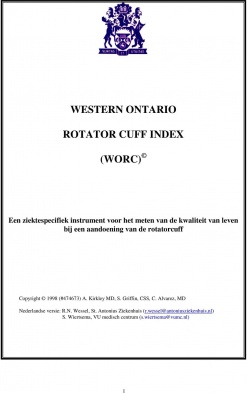Western Ontario Rotator Cuff (WORC) Index
Original Editor - Your name will be added here if you created the original content for this page.
Top Contributors - Amanda Ager, Kim Jackson and Nikhil Benhur Abburi
Objective
[edit | edit source]
Shoulder pain remains one of the main reasons to consult a physician or physiotherapist today, with up to one-quarter of the
Western population reporting a shoulder problem at any one time.1 Among shoulder disorders, a rotator cuff (RC) tendinopathy remains the leading source of shoulder pain.2-5 The Western Ontario Rotator Cuff (WORC) Index is a questionnaire that was purposely developed to help understand the particular signs, symptoms, and functional limitations associated with an RC tendinopathy.
It is an Outcome Measure used by clinicians to evaluate the condition of individuals affected by this pathology. It can help establish goals, prognostic indicators, and an overall rehabilitation plan for individuals affected by an RC tendinopathy.
Intended Population
[edit | edit source]
the WORC Index, is a disease-specific quality of life questionnaire, evaluating the change in symptoms and functional ability, specific to a RC tendinopathy.
This questionnaire has been used with individuals with a clinical diagnosis of an impingement syndrome, RC tendinopathy as well as arthroscopic RC repairs.
Method of Use[edit | edit source]
The WORC Index is a self-administering health questionnaire.
It has 21 items, exploring 5 different domains:
(1) Physical symptoms
(2) Sports and recreation
(3) Work
(4) Social function
(5) Emotions
Each question uses a visual analogue scale (VAS) - which is a straight line, representing a 100-point scale, ranging from 0-100.
The maximum score is 2100 (worst possible symptoms). Zero (0) represents no symptoms at all.
To make the final score more clinically friendly, some minor math is involved. The score can be reported as a percentage by subtracting the total from 2100, dividing by 2100, and multiplying by 100. This will give you an overall percentage. Total final WORC scores can, therefore, range from 0% ( lowest functional status level) to 100% (the highest functional status).6
Difficulty of administration: Easy.
Clarity: Very clear directions.
Scoring: Using the VAS, measure the distance from left to right, along the line. The total score is out of 100 (record the value to the nearest 0.5mm).
Final Score - 2100 (max) / 21, x 100%.
For example: A score of 1625.
(1625/2100)/21 = 22.6% (therefore, overall low functional status).
Reliability / Validity / Responsiveness[edit | edit source]
The usefulness of a tool in a clinical setting depends on how much the clinician can rely on the data and how stable the data is over time. A good tool will have strong reliability, validity, and will be responsive to change.
Reliability refers to how consistent the tool is at measuring your outcome of interest, and is it free of error.7
The WORC Index is highly reliable and has an excellent test-retest reliability (intraclass correlation coefficient) ranging from 0.85-0.99.8
The WORC Index also has a standardized response mean (SRM) of >1.3.8
Validity means that the tool is measuring what it is intending to measure.7 In the case of a questionnaire, often times they are compared to questionnaires that are already validated with the population of interest. The WORC Index was found to be highly correlated t the DASH questionnaire (r=0.78) and moderately correlated with the SF-36 (r=0.68).8
Responsiveness can best be understood as the ability of an instrument to detect clinically important changes.9 When compared to other upper-extremity questionnaires (DASH, UEFI) or shoulder specific questionnaires (SPADI, ASES, SST), the WORC Index systematically demonstrated higher responsiveness among individuals with an RC tendinopathy.8
The WORC Index sports a Minimally Clinically Important Difference (MCID) of 245 points of the total score,10 or 11.7% (11.7 points on the scaled index with maximum value of 100).11 This is the amount of change in the results of the final score of the questionnaire, that can be said to be clinically important (an important change for the patient).
An interested study by Wessel and colleagues (2018) found that patients undergoing a RC repair needed to improve more than 35 points to see a clinically important change. The WORC Index has a high responsiveness with patients undergoing rotator cuff repair and patients with an RC dysfunction, without an RC tear.12
Miscellaneous[edit | edit source]
The WORC Index is used in research13 and has already been translated into Canadian French,8 German,14 Iranian,15 Norwegian,16 Portuguese17 and Turkish18. Because of it's language versatility, it is a good tool to use for international studies and comparisons.
For more information on the subject, you can look into the Western Ontario Shoulder Tools (WORC, WOOS, WOSI)!19
Did you know that a Short Form version (7-times) of the WORC Index (Short-WORC) is up and coming? For more information, please read:
https://experts.mcmaster.ca/display/publication180754
Where did it all begin? Western University, in London, ON Canada. Check it out!
Links[edit | edit source]
Are you looking for more on this Outcome Measure? Happy reading!
Acronyms[edit | edit source]
ASES - American shoulder and elbow surgeons standardized shoulder assessment form
DASH - Disability of the arm, shoulder and hand questionnaire
ICC - Intraclass correlation coefficient
MCID - Minimally Clinically Important Difference
RC - Rotator cuff
SF-36 - Short form health survey 36
SRM - Standardized response mean
SPADI - Shoulder pain and disability index
SST - Simple shoulder test questionnaire
UEFI - Upper extremity functional index
VAS - Visual Analogue Scale
WOOS - Western Ontario osteoarthritis of the shoulder index
WOSI - Western Ontario shoulder instability index
WORC Index - Western Ontario rotator cuff Index








